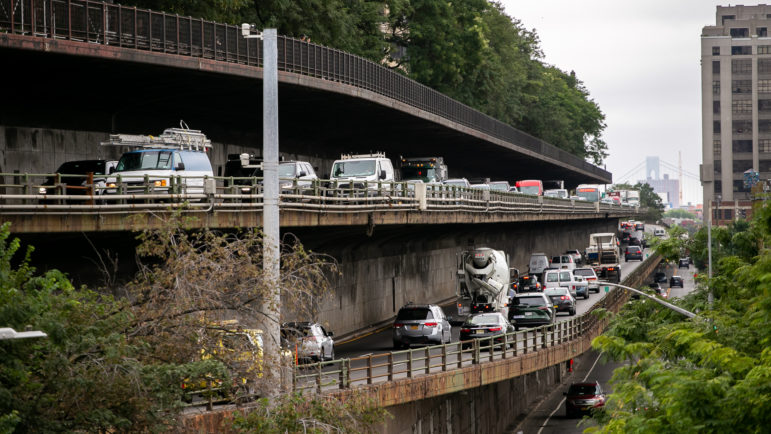The Reconnecting Communities Act which would have allocated $15 billion to retrofitting or replacing roadways that cut through economically disadvantaged areas, like the Brooklyn-Queens Expressway.

Adi Talwar
Last week, the U.S. Senate approved a $1 trillion infrastructure bill to invest in improving the country’s roadways, bridges and railways and making necessary improvements to internet connectivity, the power grid and water systems.
Approval of the bill, which passed with a 69-30 vote, was bipartisan, a rarity during increasingly politically polarizing times. But cut from the final version of the legislation was funding that would have helped mitigate an issue environmental justice and social justice activists have been fighting for: removing highways that cut through economically disadvantaged areas, like the Brooklyn-Queens Expressway (BQE).
In May, New York Senators Chuck Schumer and Kirsten Gillibrand introduced the Reconnecting Communities Act, which would have allocated $15 billion for the Department of Transportation to offer in grants over the next five years. Those dollars would be spent on projects like traffic studies, retrofitting or replacing roadways and supporting community members who participate in transportation-related decision-making. But the amount dedicated to that program was reduced to just $1 billion in the bill approved by the Senate.
“We would have liked to see additional funding toward that program, mainly because the $1 billion price isn’t up to the task,” said Ben Crowther, who co-authored a recent report for the nonprofit Congress for the New Urbanism, called Freeways Without Futures, which prioritized 15 highways across the country for such funding, including the BQE.
For context, he noted that a single priority project—to remove the crumbling Interstate-81 in Syracuse, New York, for instance—would cost upwards of $2.2 billion, according to a DOT estimate.
The future of the BQE has been a focal point of public policy discussion in recent years, with some calling for the city to tear the crumbling expressway down. Earlier this month, Mayor Bill de Blasio announced a plan to make improvements to a portion of the BQE that would extend its life by 20 years.

The highway was built over a more than 20-year period beginning before World War II, according to NYC Parks, and one of its most iconic sections, a three-layer cantilever encompassing two stacked highways topped by the Brooklyn Heights Promenade, opened in 1954. The design was a compromise between planner Robert Moses and local residents who resisted a highway cutting through their neighborhood, though the completed project effectively did cut them off from the waterway for the length of the promenade.
That 1.5-mile section running from Atlantic Avenue to Sands Street in Brooklyn is now in desperate need of repair, according to Marc Wouters, an urban planner who worked on the mayor’s approved plan for the highway.
“It was a fantastic piece of engineering for its day, but it needs maintenance,” he said. He added that experts had originally estimated the road would not be able to withstand truck traffic by 2026, a panel created by the mayor to evaluate the highway’s state found it was deteriorating faster than expected.
In 2019, the Department of Transportation put forth two proposals, and five other potential plans were proposed by other planners and groups. One of two DOT plans suggested removing the promenade and demolishing a local playground, and was met with mass opposition by Brooklyn residents and legislators, including Brooklyn Borough President and mayoral candidate Eric Adams. At the time, Adams told a local neighborhood blog that he was “united” with them in their fight against the proposal. (His office did not respond to a request for comment on the current plan.)
To choose the best course of action, Mayor de Blasio convened an expert panel who produced a report in February 202 on ways to address that section of the highway.
The plan approved by the mayor’s office this month follows suggestions by that panel and will create an opportunity to “rethink how people, goods, and services move around our city,” de Blasio said in a press release. It will reduce the six-lane highway to four, mitigate water infiltration that causes corrosion and increase enforcement of overweight trucks. The city is also using sensors to monitor the state of deterioration.
“It’s a great step,” said Woulters. But, he added, this plan mainly buys time— time the city should use to think about a long-term solution for the expressway.
“Instead of just constantly rebuilding the highways that people conceived of in the ’50s and ’60s, let’s start planning for the future,” he said. “So that as repairs come along, that we start replacing it with something that is more innovative, more forward-thinking, that’s cleaner, more sustainable, healthier for the neighborhoods that are adjacent to it.”
As for potential federal dollars to seek alternatives to massive highways through urban areas, Crowther said that the infrastructure bill, which is now being considered by the House of Representatives, allows for other methods of funding. The legislation allocates additional discretionary funds to the Department of Transportation, for instance, and DOT Secretary Pete Buttigieg has been supportive of removing highways.
“So while we would have liked to see a more robust Reconnecting Communities Program included in the bipartisan infrastructure bill,” he said, “there’s still other pathways at the moment to get some of that funding for these projects.”
Liz Donovan is a Report for America corps member.








3 thoughts on “Infrastructure Bill Cuts Federal Funds to Remove Highways, As Mayor Proposes BQE Fix”
A big question is how to get freight from Staten Island to Long Island. Right now, the only answer is via the BQE. What’s the alternative?
Good question, since commercial vehicles are not allowed on the belt parkway.
Actually the question should be: How do you get Mid-Atlantic truck traffic to New England while not tying up the GWB? The I-278 was built to get truck traffic from the New Jersey Turnpike(I-95) to the New England Turnpike(I-95) without going through Manhattan(illegal) or across the GWB or on the Cross-Bronx Expressway(impassible even now). Long Island and local deliveries are not the priorities. There is no alternative route except a freight train tunnel.
Just wait until they start re-building the Cross-Bronx. Won’t that be fun.